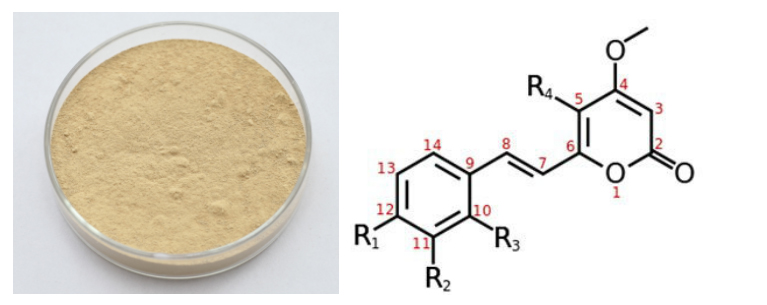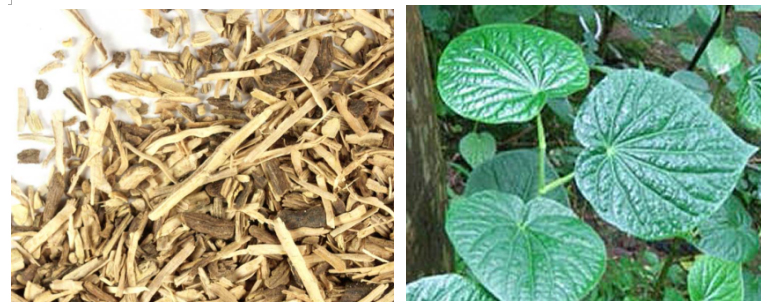14 Years Manufacturer Kava Extract in Lesotho
14 Years Manufacturer Kava Extract in Lesotho Detail:
[Latin Name] Piper methyicium L.
[Specification] Kavalactones ≥30.0%
[Appearance] Yellow powder
Plant Part Used: Root
[Particle size] 80Mesh
[Loss on drying] ≤5.0%
[Heavy Metal] ≤10PPM
[Storage] Store in cool & dry area, keep away from the direct light and heat.
[Shelf life] 24 Months
[Package] Packed in paper-drums and two plastic-bags inside.
[Net weight] 25kgs/drum
[What is Kava?]
Kava, also known as piper methysticum, kava kava, and ‘awa, is a small shrub native to the islands in the South Pacific. The root and stems are made into a non-alcoholic, psychoactive beverage that has been used socially and ceremonially for hundreds of years in Hawaii, Fiji, and Tonga.
Kava is traditionally prepared by placing ground root and stem into a porous sack, submerging in water, and squeezing the juice into a large, carved, wooden bowl. Coconut half-shell cups are dipped and filled — punch bowl style. After drinking a cup or two a feeling of heightened attention combined with relaxation begins to come on. Although it is soothing, it is unlike alcohol in that thoughts remain clear. The flavor is largely inoffensive, but some find that it takes getting used to; it really depends on your preference for earthy flavors.
[Kava is Safe to Use]
The safe and effective benefits of kava to relieve symptoms of anxiety were also supported in a meta-analysis, a systematic statistical review of seven human clinical trials published in 2000 in the Journal of Clinical Psychopharmacology, and again in a similar critical review in 2001. The reviews did not find significant adverse effects related to liver toxicity.
In conclusion, the liver is affected by many substances, including prescription and non- prescription drugs, as well as alcohol, which is a major cause of liver damage. We must be aware that herbs are potent medicines, to be treated with the appropriate respect regarding potential interactions and toxicity, including to the liver. On the other hand, Kava kava’s margin of safety far surpasses that of it’s pharmaceutical equivalent.
[Function]
Kava’s can help offset a number of problems, most notably stress, anxiety, and disrupted sleep patterns. However, kava’s anxiolytic (anti-panic or anti-anxiety agent) and calming properties can offset many other stress and anxiety related ailments.
1. Kava as a Therapy for Anxiety
2. Kava May Remedy Menopausal Mood Swings
3. Weight Loss
4. Combat Premature Aging
5. Quit Smoking Aid
6. Combat pain as an analgesic
7. Insomnia
8. Depression
Product detail pictures:

Related Product Guide:
Our firm promises all consumers with the first-class products as well as most satisfying post-sale services. We warmly welcome our regular and new consumers to join us for 14 Years Manufacturer Kava Extract in Lesotho , The product will supply to all over the world, such as: Guatemala, Vietnam, Belize, We insist on "Quality First, Reputation First and Customer First". We are committed to providing high-quality products and good after-sales services. Up to now, our products have been exported to more than 60 countries and areas around the world, such as America, Australia and Europe. We enjoy a high reputation at home and abroad. Always persisting in the principle of "Credit, Customer and Quality", we expect cooperation with people in all walks of life for mutual benefits.
By 2030, 193 world countries adopted the Sustainable Development Goals. Willing to play an active role? Join the SDG Summer School at Geneva and Tsinghua Universities. For two months you will work in teams, in collaboration with the UN and other international organizations, to design and deploy practical solutions for the goals. Register by May 15! https://gt-initiative.org/summerschool/
If there’s one setback to turning 40, it’s the declining metabolism. Alas, you can’t inhale double bacon cheeseburgers like the metabolic champ you were in youth.
High in protein and low in fat, the sweet flesh of the king crab is spiked with zinc–a whopping 7 milligrams per 3.5-ounce serving. “Zinc is an antioxidant, but more important, it helps support healthy bone mass and immune function,” says Susan Bowerman, assistant director of the Center for Human Nutrition at the University of California at Los Angeles.
Also known as prunes, these dark shrivelers are rich in copper and boron, both of which can help prevent osteoporosis. “They also contain a fiber called inulin, which, when broken down by intestinal bacteria, makes for a more acidic environment in the digestive tract,” says Bowerman.
This crunchy cruciferous vegetable is more than the filler that goes with shrimp in brown sauce. “Bok choy is rich in bone-building calcium, as well as vitamins A and C, folic acid, iron, beta-carotene, and potassium,” says celebrity trainer Teddy Bass.
Shellfish, in general, is an excellent source of zinc, calcium, copper, iodine, iron, potassium, and selenium. “But the creamy flesh of oysters stands apart for its ability to elevate testosterone levels and protect against prostate cancer,” says Bass.
Athletes and performers are familiar with the calming effect of bananas–a result of the fruit’s high concentration of tryptophan, a building block of serotonin. But their real benefit comes from potassium, an electrolyte that helps prevent the loss of calcium from the body.
Like bananas, this fuzzy fruit is high in bone-protecting potassium. “They’re also rich in vitamin C and lutein, a carotenoid that can help reduce the risk of heart disease,” says Bowerman.
Our president’s dad may hate this cruciferous all-star, but one cup of broccoli contains a hearty dose of calcium, as well as manganese, potassium, phosphorus, magnesium, and iron. And that’s in addition to its high concentration of vitamins–including A, C, and K–and the phytonutrient sulforaphane, which studies at Johns Hopkins University suggest has powerful anticancer properties.
A renowned muscle builder, spinach is also rich in vitamin K, which has been shown to bolster bone-mineral density (thus protecting against osteoporosis) and reduce fracture rates. Spinach is also high in calcium, phosphorus, potassium, zinc, and even selenium, which may help protect the liver and ward off Alzheimer’s.
These scallionlike cousins of garlic and onions are packed with bone-bolstering thiamine, riboflavin, calcium, and potassium. Leeks are also rich in folic acid, a B vitamin that studies have shown to lower levels of the artery-damaging amino acid homocystein in the blood.
Lauded for centuries as an aphrodisiac, this fiber-rich plant contains more bone-building magnesium and potassium than any other vegetable. Its leaves are also rich in flavonoids and polyphenols–antioxidants that can cut the risk of stroke–and vitamin C, which helps maintain the immune system.
Studies show that green tea–infused with the antioxidant EGCG–reduces the risk of most types of cancer. “The phytonutrients in tea also support the growth of intestinal bacteria,” says Bowerman.
“Chilis stimulate the metabolism, act as a natural blood thinner, and help release endorphins,” says Petersen. Plus, they’re a great way to add flavor to food without increasing fat or calorie content.
Contrary to popular belief, ginger–a piquant addition to so many Asian dishes–isn’t a root, it’s a stem, which means it contains living compounds that improve your health. Chief among them is gingerol, a cancer suppressor that studies have shown to be particularly effective against that of the colon.
“This potent little fruit can help prevent a range of diseases from cancer to heart disease,” says Ryan Andrews, the director of research at Precision Nutrition, in Toronto, Canada. One serving (3.5 ounces) contains more antioxidants than any other fruit.
Known for making desserts sweet and Indian food complex, cinnamon is rich in antioxidants that inhibit blood clotting and bacterial growth (including the bad-breath variety). “Studies also suggest that it may help stabilize blood sugar, reducing the risk of type 2 diabetes,” says dietitian Nancy Clark, author of Nancy Clark’s Sports Nutrition Guidebook.
Often confused with yams, this tuber is one of the healthiest foods on the planet. In addition to countering the effects of secondhand smoke and preventing diabetes, sweet potatoes contain glutathione, an antioxidant that can enhance nutrient metabolism and immune-system health, as well as protect against Alzheimer’s, Parkinson’s, liver disease, cystic fibrosis, HIV, cancer, heart attack, and stroke.
“I think of tomatoes as the ‘fighting herpes helper’ for the divorcé crowd,” says Petersen. Their lycopene content can also help protect against degenerative diseases.
Packed with potassium, manganese, and antioxidants, this fruit als
This company can be well to meet our needs on product quantity and delivery time, so we always choose them when we have procurement requirements.







